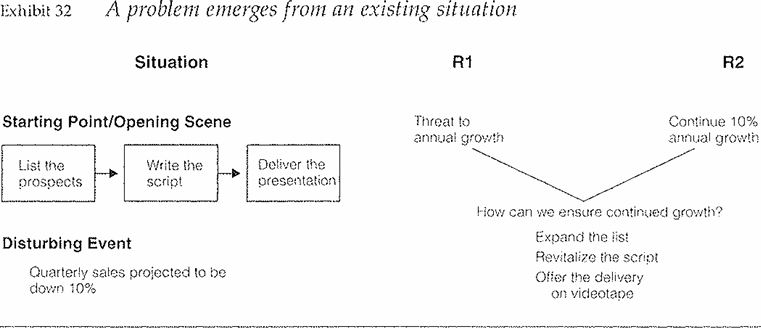
Laying out the Elements
 المؤلف:
BARBARA MINTO
المؤلف:
BARBARA MINTO
 المصدر:
THE MINTO PYRAMID PRINCIPLE
المصدر:
THE MINTO PYRAMID PRINCIPLE
 الجزء والصفحة:
122-8
الجزء والصفحة:
122-8
 2024-09-16
2024-09-16
 928
928
Laying out the Elements
Let me explain the elements of the framework using a deliberately simplistic example. Suppose you have a company that has for 30 years followed a tried-and-true method to sell a product that is in enormous demand, say industrial real estate. The salesmen simply make a list of their sales prospects, write a script of what they will say to the prospects, and then deliver the message.
The company has done phenomenally well over time, increasing its sales some 10% a year every year. This year, however, as it goes into the final quarter, indications are that sales instead of being up 10% will be down 10%. The news is naturally something of a shock, and the company wants to take action as quickly as possible to get sales back on track.
Think of the problem as emerging from an existing Situation (Exhibit 32). This Situation is made up of a Starting Point or Opening Scene that encompasses an existing structure or process (their standard selling approach). The process yields or is expected to yield a Desired Result (R2) of continued 10% annual growth. Something has happened or an action has been taken in the Situation (they calculated their projected sales) that led to the acknowledgement or revelation of a likely Undesired Result (R1), the threat that sales growth will be lower than expected.

A gap now exists between what was delivered and what was expected. That gap is the problem. To solve the problem, one has to identify the causes of the gap and determine the steps required to close it. These causes will generally lie in the activities envisioned in the Opening Scene. Thus the Problem Definition Framework requires you to answer three questions:
- What's going on?
(Situation [Starting Point/Opening Scene+ Disturbing Event])
- What don't we like about it? (R1)
- What do we want instead? (R2)
Once these questions are answered, the problem is defined to the point where you can determine the Question generated by the problem and begin to look for the Solution. The Solution generally comes from changing what is going on in the structure or process identified as the original Starting Point/Opening Scene. In the case just described, if the sales are down, they are likely down because
-The list is no longer valid, and/or
-The script is not punchy enough, and/or
-The delivery is ineffective.
You are now in a position to structure the analysis of the problem. To that end, you will develop diagnostic frameworks and logic trees that enable you to do a complete breakdown of each area to identify the causes of sales being down. The steps in your solution will derive from these frameworks, and would likely cover fixing the list and/or the script and/or the delivery (Structuring the Analysis of the Problem, explains diagnostic frameworks for problem analysis and how to develop them.)
 الاكثر قراءة في Writing
الاكثر قراءة في Writing
 اخر الاخبار
اخر الاخبار
اخبار العتبة العباسية المقدسة


